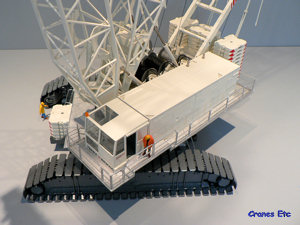 | | The distinctive boxy structure. |  | 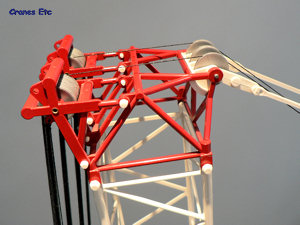 | | Detail at the boom head. | 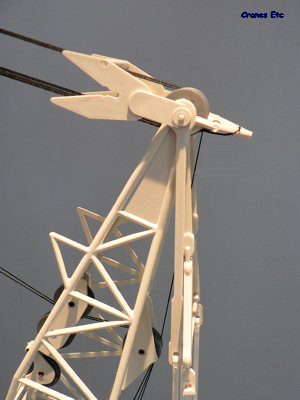 | | Detail at the top of the back mast. | 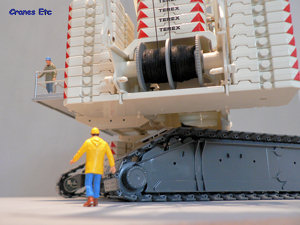 | | Massive counterweight stacks. | 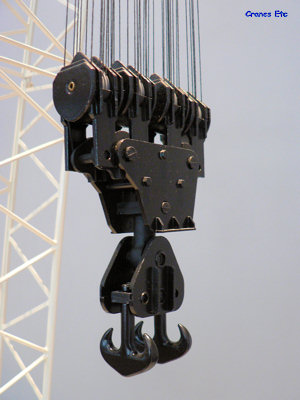 | | A fantastic heavy lift hook. It certainly weighs heavily on your patience trying to reeve it. | 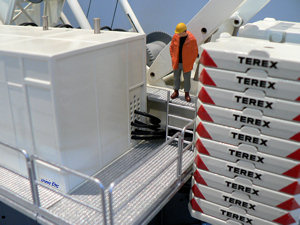 | | Hydraulic lines to the winches. | 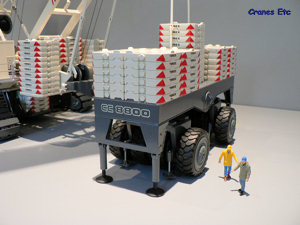 | | The ballast carrier fully loaded. | 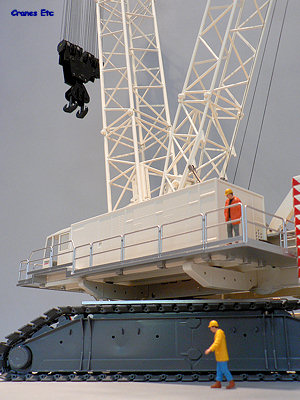 | | Huge track frames - and everything else. | 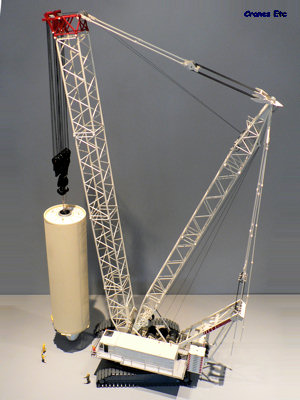 | | Lifting a fermentation tank. Actually a light load for the CC 8800 so no ballast carrier required. | 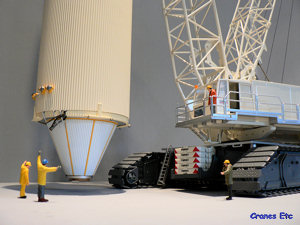 | | The Cranes Etc team fail to agree what to do next. |
| This crawler crane is one of the largest in the world and the model was exhibited at the 2004 Nuremberg Toy Fair where it was voted a winner in the Innovation category.
Packaging
The box this model comes in is very large and this is reinforced by the weight which approaches the 20kg mark. Within the picture sleeve cover are three polystyrene trays of parts. The review model was undamaged during transport. However the ballast weights are tightly packed within their own polystyrene boxes which are then packed inside some of the larger jib sections. On opening these it was found that the pieces had stuck together probably as a result of packing too soon after painting. Separating the parts damaged the paint but this was subsequently rectified by Conrad.
A comprehensive 24 page instruction book is supplied with the model. This is a black and white manual printed in German and English with many pictures. The English is not perfect and some of the graphics are less clear than they should be. In particular the reeving graphics suffer from some poor definition. With that said the instructions should enable most people to build the model without a problem.
Detail
The model is a faithful representation of the real crane with most parts being supplied in the real configuration. One of the exceptions to this is the track frames which split in two in real life, but on the model are a single piece. Each track frame is huge and is not far short of the size of a five axle crane model. The frames are well detailed with cast flanges and lugs and there is some fine detail in the drive sprockets. Each track is made up of a large number of individual metal links. These are clipped together and are very good. However any looseness in the clipping between an individual pair links will tend to lead to tracks springing apart. This is easily cured by gently compressing the track clips in question with a pair of pliers. Only one pair of links were affected like this on the review model and the above action solved the problem.
The crane sits on a very large chassis mid section which is pinned to two cross pieces and there is a screw jack at both ends of each cross piece which replicates the hydraulic jack outriggers of the original. With these three parts assembled a very heavy H-section (in plan) is created which stands on the outriggers awaiting the attachment of the track frames which is achieved with large plastic pins. Although they work well they are unfortunately white rather than the grey of the track frames so they are more obtrusive than they needed to be.
The chassis is completed with the addition of walkway plates and ladders, all of which are metal. Two ballast trays are also attached and these carry five pieces each. In fact the model uses 90 ballast weights in all. Each one is metal and cast with lifting lugs. These weights alone account for a significant part of the weight of the overall model.
The crane superstructure is a second component which models more than one piece of the original. The original splits into two pieces just behind the third winch drum however the connection details at least are cast in to the model. The superstructure is another very heavy piece and connects to the chassis with a large screw. This arrangement works well but does mean that the crane should not be turned in one direction too much as this has the effect of loosening or over tightening the screw. The superstructure also has the transverse support beams that support the cab house permanently fixed so unfortunately this part does not look right on a transporter. Three winch drums are fitted, with a fourth at the rear for the back mast. These drums are not pre-strung so expect to spend some time feeding the supplied ropes onto the drums. Reeving the back mast is straightforward but there is a complication. The drum is split so that two independent lines work in unison to control the back mast luffing. On the model it is difficult to achieve equal tension in each line and this problem is accentuated by the bridle for the back mast being a single piece which therefore does not have a tension equaliser. Almost all parts on the superstructure are metal, with the exceptions being hydraulic cylinder casings and the pulleys which are plastic.
The large cab and motor house comes as a single piece complete with permanently fixed walkways so again it is a little too wide to fit on a transporter properly. This piece is very well made with excellent hand railing. The cab has a working sliding door and reasonable internal detail. Windscreen wipers are moulded into the windscreen and would have looked better as separate pieces or at least painted black. Hydraulic lines from the motor house to the winches are supplied as separate lengths of plastic which can be fixed through the appropriate holes. This is a simple and effective detail.
The main jib sections are massive pieces compared to other models in this scale. They are metal and very well made. Connection of the pieces is by the usual Conrad system of plastic pins which are suitably large. This is a very big model and if built up to its full height with additional sections would apply some significant loads through the pins so hopefully these are up to the job. The main jib head comes as a pre-assembled piece which consists of three parts pinned together. Pulleys are plastic but are free-rolling and well made. The back mast is similarly made up of high quality pieces. All the pendant bars on the model are plastic and these are strong enough to, for example, lift the ballast carrier fully loaded, however they do not match the look and feel of metal components.
The ballast carrier is larger on its own than most models in this scale. Two rotating axles have four tyres each. Interestingly the plastic hubs on these tyres are exactly the same as those used on the front wheels of the Liebherr T262 Mining Dump Truck, with the colour being the only difference. Four screw jacks are provided on each axle and four large jacks are on the corners of the carrier. Fully loaded the carrier is very heavy and the model takes the weight well. The carrier connects to the crane superstructure through a telescopic tube so the distance between crane and carrier can be increased for the heaviest lifts. Unfortunately this tube does not readily disconnect from the carrier so again this part cannot be sensibly be posed on a transporter.
The hook block is a gigantic piece almost all of metal. The pulleys are plastic as are some of the connecting pins which hold the parts of the block together. Reeving the hook is a challenge because of the number of falls of rope involved and the somewhat tricky nature of feeding the rope through the pulleys.
Features
The tracks are excellent and work well when carrying the weight of the model. Each track frame is spring loaded at one end so removing the tracks is readily done by compressing the ends and detaching the tracks.
The cab door slides open and shut.
The crane slews well with or without the ballast carrier. Luffing the back mast and the main jib is done by turning the appropriate winches with the only problem being the large numbers of rotations of the winch drums tending to cause a degree of soreness in the finger being used. The same is also true of the hoist drums.
The crane can be configured in a variety of set ups, although alterations are not trivial because of the amount of re-reeving that may be required. As mentioned previously not all parts can be realistically posed on low loaders.
Quality
This model is very well made. Castings are suitably detailed and also massive as befits the crane being modelled. Paintwork and lettering is good, and the higher standard of instructions supplied is welcomed even though they could be improved further. There is relatively little plastic used.
Price
The CC8800 model costs a great deal compared to other models in this scale, and the shipping charges alone are significant due to the size and weight. However a lot is provided for the money and in terms of kilos of metal alone the model represents very good value.
Overall
This is a behemoth of a model and it is hard to believe that it is 1:50 scale when compared to more 'normal' models. At the same time detail has not been sacrificed. The CC8800 is one of those models that will make the jaws drop of people who are collectors and non-collectors alike. It is huge and impressive, and with extra jib sections and a luffing fly jib a very large display area is needed. There are few complaints about this model. It would have been even better if all parts could have split down like the real machine and if some of the plastic components such as pendant bars were made of metal. However setting aside these minor points this is a must have model for the heavy crane collector.
Footnotes
The model first appeared in 2003. At the BAUMA exhibition in April 2004, the luffing fly jib attachment was introduced (model number 98011). Additional boom sections were sold separately from 2005 (model number 99906). A limited edition run of 250 models in 'Sarens' livery appeared in March 2006.
|
| |
| 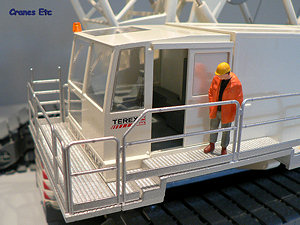 | | Opening door to the spacious cab. | 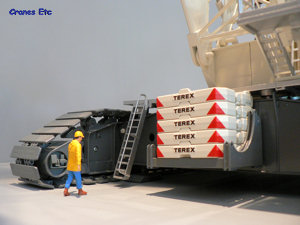 | | Access stairs to the deck. | 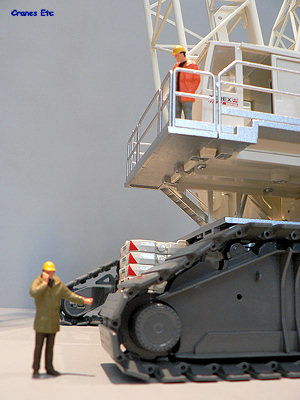 | | Massive proportions in 1:50 scale. | 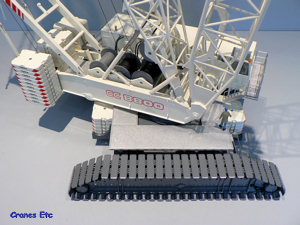 | | From the deck you can head towards the cab. | 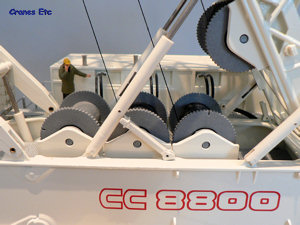 | | Giant winch drums. | 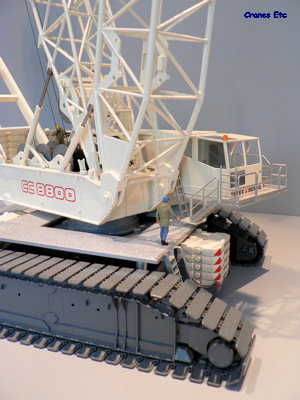 | | Definitely a heavy metal crane. |  | | The model won a major award at the Nuremberg Toy Fair in 2004. | 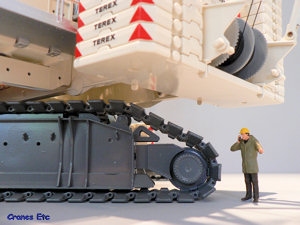 | | No need to get wet if it rains. | 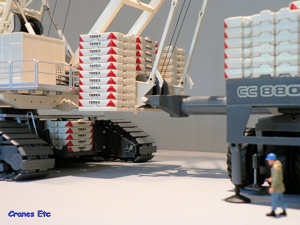 | | The connection of the ballast carrier to the crane. | 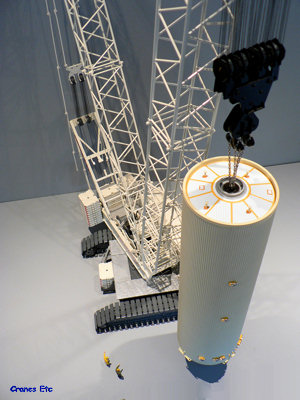 | | A model guaranteed to impress. |
|

